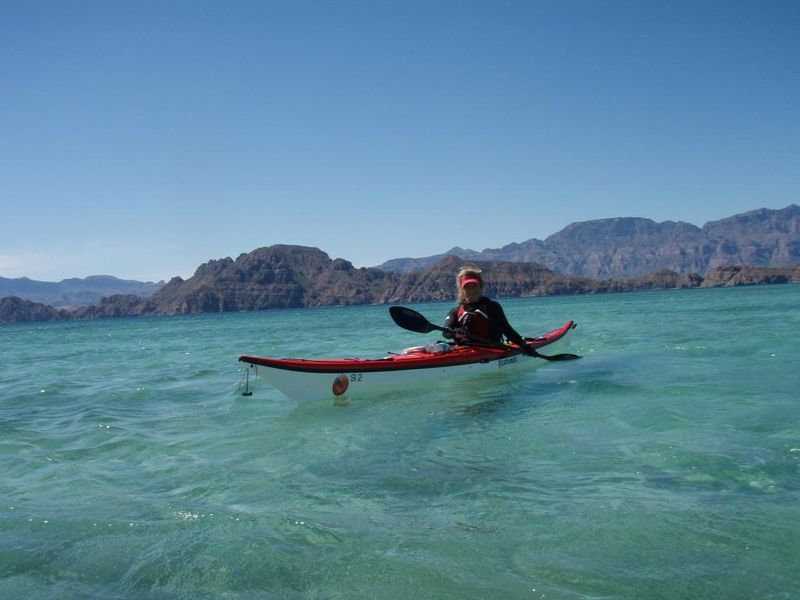By Mary Fairchild
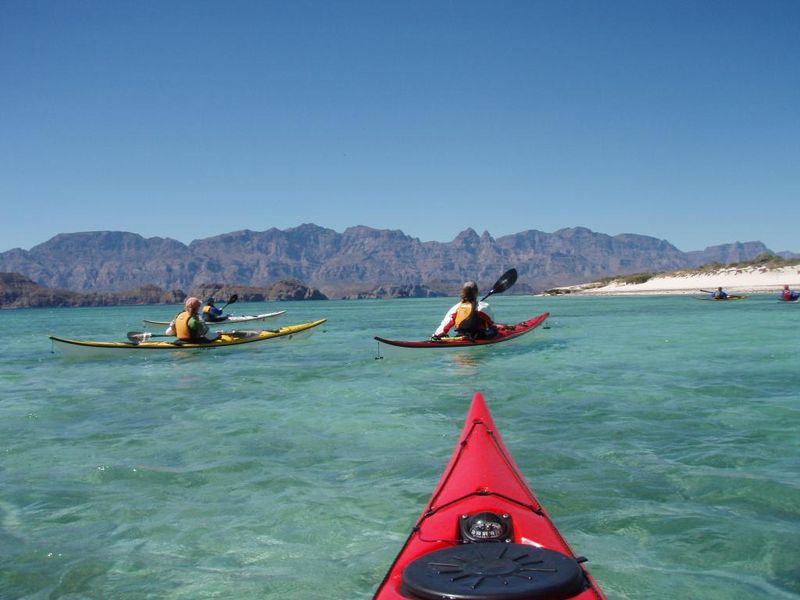 Loreto Bay National Marine Park. Pictures on Mfairlady Flickr here.
Loreto Bay National Marine Park. Pictures on Mfairlady Flickr here.
Our trip began in the little seaside fishing village of Loreto where we had breakfast together in a local restaurant with a local Chihuahua that sat near our table while I caught up on the local news in the “Gringo Gazette.”
The waters around Loreto and the beaches of its nearby islands are part of the Loreto Bay National Marine Park. The Park was established by the federal government in 1996 to help preserve the area biosphere. There are concerns today as tourism and populations increase, as to how there can be significant development allowed around the shores of a marine park when there is a symbiotic relationship between the land and the water.
Ginni Callahan of Sea Kayak Baja provided us with local knowledge and nice equipment including NDK fiberglass boats and carbon paddles. Our first day was a short paddle from the Bay of Loreto up to Isla Coronados.
Within the first half hour of our paddle we could see the water was clouded with tiny plankton. The fish, plankton and other nutrients are mixed around creating what is the known as the richest body of water on the planet. The nutrients are affected by different currents and movements throughout the sea which keeps the fish populations well fed.
Recently, researchers from the Monterey Bay Aquarium Research Institute began three months of study of the active volcanic region near the mouth of the gulf called the Alarcon Rise. Volcanic “spreading centers” such as the Alarcon Rise in the Sea of Cortez are hotbeds of volcanic activity where underwater volcanoes spread lava across the seafloor and hydrothermal vents spout out water heated by magma beneath the seafloor to over 550 degrees Fahrenheit. The hydrothermal vents transport heat and chemicals into the ocean, providing an energy source that supports a large community of sea organisms, many of which are not found anywhere else. MBARI’s flagship research vessel, Western Flyer, was named after the boat that writer John Steinbeck and marine biologist Ed Ricketts used for a groundbreaking expedition to the gulf in 1940. Their journey of scientific discovery and adventure is recorded in the book The Log from the Sea of Cortez.
The shoreline at our first campsite on Isla Coronados was a gorgeous aqua-marine blue and very shallow. I stayed back to explore a little while everyone else began emptying their boats to set up camp. Soon, I spotted bright, beautiful starfish, black crabs scrambling across the boulders, and then some beautiful red Sally Lightfoot crabs. Isla Coronados has a 500′ volcano. There are low beaches on the SW corner to large rock formations on the steep northern end. On calm days you can park on the rocks on the outside of the island and go snorkeling.
After a short hike we had dinner and then settled in our sleeping bags for the night. Soon, a strong wind began to pick up in our protected bay. We decided to turn our kayaks sideways and lay beside them for some protection. Just as we were about settled, there where spouting noises echoing across our small bay as about a dozen large dolphins began to jump and entertain us. We sat on our sleeping bags and tarps and enjoyed the show!
El Norte is a strong wind that periodically gallops down the coastline of the Sea of Cortez like a runaway bull.
From December to March the winter northerlies, which are the strongest winds and are called “El Norte,” come up very quickly on the sea. The worst winter wind storms make paddling impossible for three days at a stretch. In the desert they can cover a truck with sand in less than an hour. (1)
Typically, you will first notice huge blasts of wind in the middle of the night that announce the arrival of El Norte. These winds roar down the middle of the Sea of Cortez.
In the morning we headed around the north end of the island and the marine report had a west wind in our favor so we didn’t mind that it would be 15kts+. The north end is the surf exposed end of the island where conflicting currents create confused seas. We leisurely enjoyed the sights as we first headed around the north end where there is a sea lion rookery.
“The shallow Carmen channel gets active in a wind.”(2, p. 160.)
As we began our crossing to Isla Carmen we had what would be the first of many discrepancies in the marine forecasts. A steady southwest wind gusting to 15+mph was surprisingly funneling up the channel between Isla Coronado and Isla Carmen creating 3-4’ beam seas with occasional whitecaps and 5’ waves. Whitecaps usually appear sooner on saltwater, but as a rule they usually appear with wind above 15kts.
We decided to travel in pairs and I teamed up with Sue. Occasionally we would lose sight of each other behind the seas. It was really fun to put to practice paddling in a beam sea. We needed to find our range and hang in there for sustained wind gusts for seven nautical miles. My mantra was “paddle, paddle-rudder; paddle, paddle-rudder.” I took down my upwind leg and pressed up with the other knee to keep the perfect boat lean into the waves. The key is to always lean into the waves for stability.
About half way through the crossing we began to spot dolphins surrounding and circling us. It was really fun to paddle along with them.
We had four campsites on the mountainous Isla Carmen. The 19-mile-long island is privately owned, at least in part by the salt company that built the small town on its east side and mined the flats there. Isla Carmen’s long north end is comprised of three distinct points: Puntas, Cholla, Tintorera, and Lobos. These points and the distance between them create a potential navigational hazard if the weather comes from the north.(2, p. 160.)
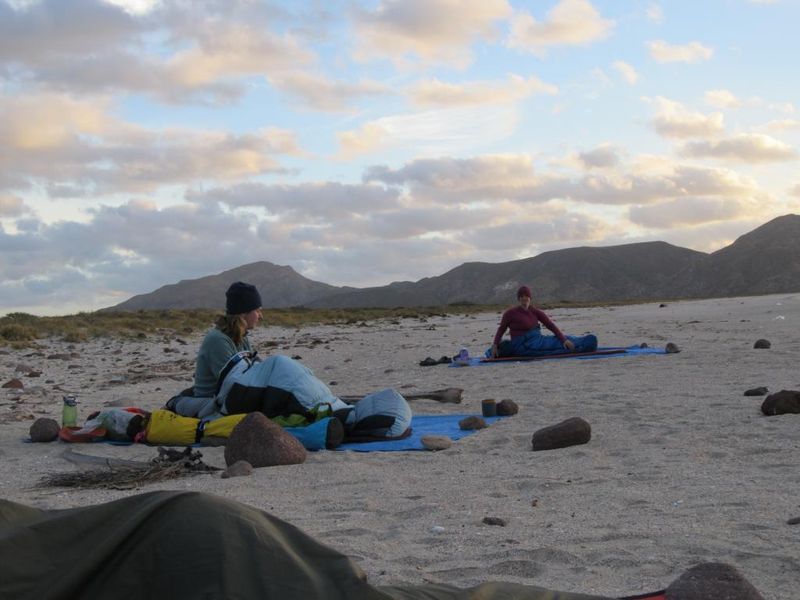 Marybeth Dunne and Allison Schroeder. Playas Salinas; Isla Carmen.
Marybeth Dunne and Allison Schroeder. Playas Salinas; Isla Carmen.
After our third night of continual winds often coming from all directions we just prepared for it by bundling up and sometimes retreating to our sleeping bags to warm up. Throughout the night wind gusts would swirl around our faces and we would totally tuck our heads in. While paddling, we knew to expect only rare breaks from the wind that would not last long.
We had chap lips early on in the trip and my medicated lipstick was re-applied often. I found keeping a bandanna around my neck was the best way to wipe my tearing eyes. We only had a brief issue with dew on our sleeping bags when there was a slight break in the overnight wind–but, by the time we had to pack the morning wind and sun sufficiently dried everything again.
Typically, you will first notice huge blasts of wind in the middle of the night that announce the arrival of El Norte. These winds roar down the middle of the Sea of Cortez.
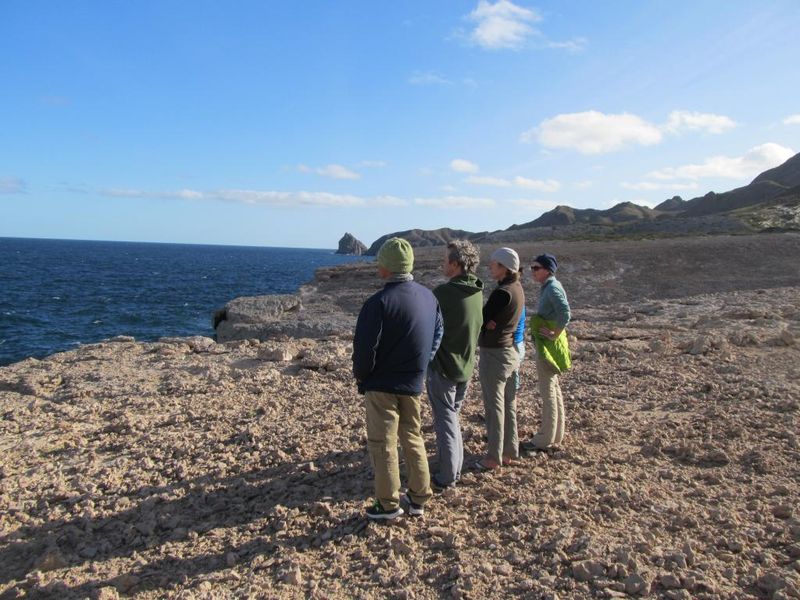 Scouting from a cliff to see if it was a “no go” morning; Isla Carmen.
Scouting from a cliff to see if it was a “no go” morning; Isla Carmen.
Weather and local conditions, more than your experience level in kayaking, usually determines the difficulty of a route. Most important is your decision to stay on land or go. Our group decided to reverse the direction of our route to avoid up wind paddling as much as possible.
According to a local wind surfing website, the strong El Norte wind patterns pack gusty winds in the 20-30 kt. range every several weeks in winter. These winds occur after a storm passes over California and high pressure that follows the storm settles for a day or two in the four corners (where all the square states meet in the US). This creates a strong pressure gradient from the four corners to low pressure south of Baja. This high pressure is strongest at night when the frigid airs of the four corners strengthen the high pressure. Typically, you will first notice huge blasts of wind in the middle of the night that announce the arrival of El Norte. These winds roar down the middle of the Sea of Cortez. A lot of the force of El Norte is from winds just aloft that make the surface wind up and down. Sometimes the wind just aloft is NNW which tends to blow the El Norte surface wind away from shore. This often means on and off wind at the beaches. (4)
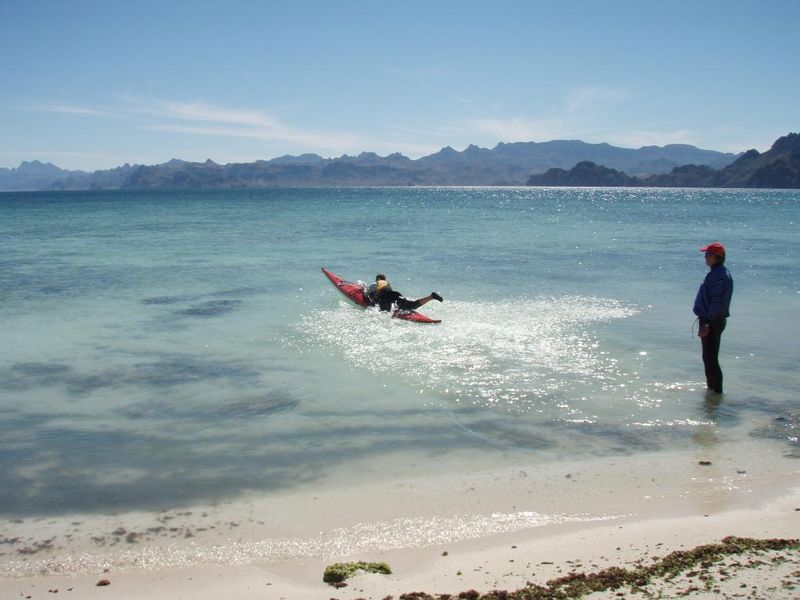 Sue Gjerset speed launching; Punta Baja Norte.
Sue Gjerset speed launching; Punta Baja Norte.
Punta Baja Norte, our last campsite on Isla Carmen, was the most sheltered and the warmest. We actually got hot in the mid-day sun and played and practiced rolls and rescues that day until the wind started up again. In the morning we had a fairly calm crossing over to Isla Danzante.
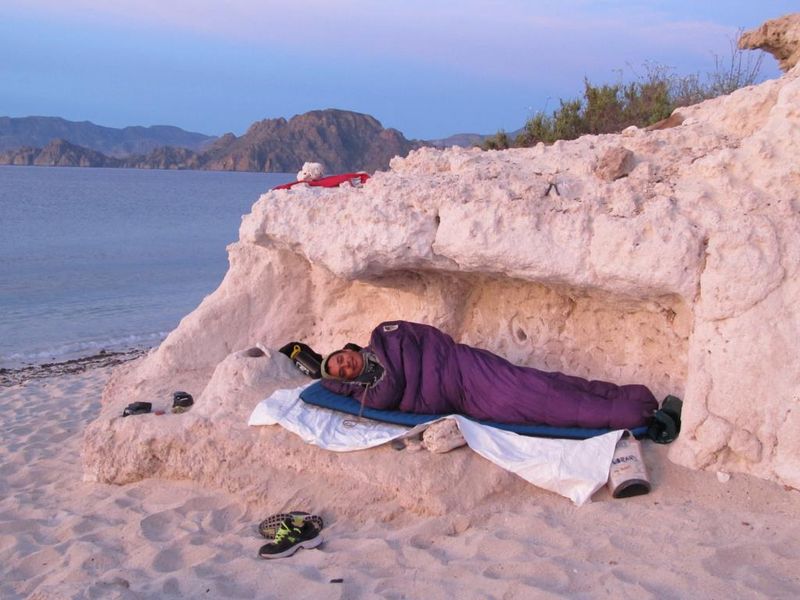 Ramon had a nice little bunk on Punta Baja Norte.
Ramon had a nice little bunk on Punta Baja Norte.
Many of us heard it, but Ramon was the only one to see the tail of a whale as we made our crossing from Isla Carmen to Isla Danzante. From January to March pregnant California Gray whales give birth and nurture their young in the warm waters of the Sea of Cortez before returning to the Bering Sea.
Portions of the Sea of Cortez are also recognized as important nursery areas for great white sharks. According to the publisher of Baja Life Magazine, however, the local fishermen have been targeting them for their fins and jaws. He reported last April that 13 large sharks had been killed in just a few weeks alone. Shark jaws are sold locally for about $1,500 per set, then re-sold by more entrepreneurial types and some fishermen north of Loreto use baited hooks beneath air-filled barrels which tire and drown the sharks before they take them to shore.
The popular dive spot about 40 miles north of Loreto off Isla Ildefonso is said to be a popular fishing spot. This past December there was a celebration of the tagging and study of the life history of 4 female Guadalupe white sharks. All 4 sharks gave their full two year migratory routes, identifying when and where they breed, where they feed and where they give birth. Now there is a concern to push for added protection of the white sharks in the Sea of Cortez and the rest of Mexico where they are under a lot of pressure. (5)
Surfers, swimmers, snorkelers, spearfishermen even a stand-up paddler have all fallen victim to shark attacks in the past year. Randy Honebrink, a DLNR shark expert, reported that there is definitely more bites this year than any other year he’s seen. We don’t know a lot about the great whites yet, but generally, sharks are a negligible danger when you are boating or diving.
Spear-fishing is dangerous because shark hone in on prey using sound, smell, and vision. They are attracted by rythmic vibrations such as those by a fish struggling on a spear–possibly a kayaker’s paddling or movements to re-enter their boat. Sharks are also very sensitive to blood trails–perhaps even a women’s menstrual cycle–that is carried by tidal currents. Visually they are excited by a thrashing or helpless fish.
Surfer Magazine, May 2012: “I’ve been surfing here for 19 years now, and …something just doesn’t feel right here anymore,” says Marais. “We are interfering way too much with the great whites, with chumming the waters and cage diving, and I believe this may be causing the sharks to behave unnaturally.” …False Bay and nearby Gansbaai are home to one of the largest great white populations in the world, thanks to the booming seal population there. Currently, there are 11 licensed shark cage diving businesses operating within this 60-mile stretch, with another two operators in Mossel Bay, a small coastal town a couple hundred miles away. Operators use a bloody mixture of sardines, tuna heads and fish oil to lure sharks closer to their boats so tourists can observe them from a cage lowered into the water. Anti-chummers have long maintained that this encourages an unnatural association between sharks, humans, and the promise of food, altering the behavior of sharks and leading to more shark-human interaction. On the other hand, local shark scientists and operators refute this, claiming the amounts of chum are so small they are negligible and that no significant conditioning takes place. While cage diving in Australia is confined to the remote Neptune Islands, False Bay sits in the middle of Cape Town, the second largest city in South Africa with a population of 3.5 million. A week before the attack on Lilienfeld, authorities granted an additional permit to the reality show Sharkmen, led by the controversial Chris Fischer, to conduct shark-tagging research aboard the Ocearch vessel. The research entailed great whites being hooked, sedated, hauled out of the water, measured and sampled, then tagged with electronic transmitters and released again. The Ocearch permit allowed for five tons of chum to be used over a 20-day period between False Bay and Gansbaai. The official daily chum limit is usually 55 pounds per operator. The Ocearch permit sparked public outrage after Dr. Dirk Schmidt, a wildlife photographer and author of the renowned book White Sharks, questioned why the public weren’t informed or consulted…. While authorities continue to assure the public their concerns are unfounded (while excluding them from any decision making process), many surfers remain unconvinced. As lifelong False Bay local, Philip Nel says “The question that I will mull over while driving to Caves next time is not if, but to what extent the cage diving industry have already conditioned our shark population’s behavior.” Surf Magazine
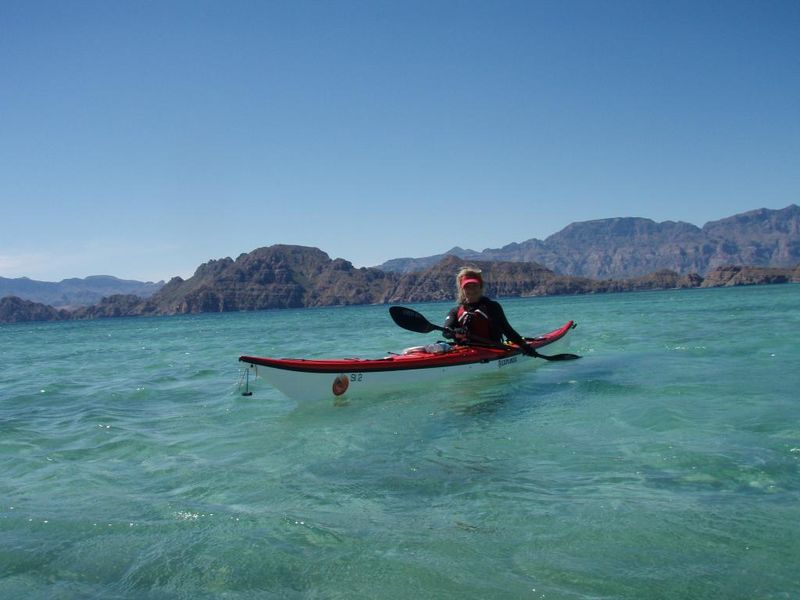 Mary Fairchild, Punta Baja Norte. Mfairlady Flickr
Mary Fairchild, Punta Baja Norte. Mfairlady Flickr
There is a pleasant sense of wonder when you take in the natural world and realize how much you do not know. There is a great expanse of things unsolved. At one time the Baja peninsula was thought to be an island where, according to legend, gold and pearls were controlled by Amazon women and men were only used for procreation. After conquering Mexico, Hernan Cortez set out to conquer this island but was unsuccessful. When early missionaries to Baja inquired about the cave paintings in the area, the native people answered that they were painted by an ancient race of giants.
Just prior to his travels in the Sea of Cortez, novelist John Steinbeck wrote “The Grapes of Wrath” which portrayed the farm families from western Oklahoma who went to California in search of jobs. Most families, however, did not experience the hardships that he presented in his novel. Although the Hollywood movie version was an attempt at showing the sufferings of the “typical” American, it backfired. Rather than believing that free enterprise in America had failed, Russians left thier theaters envious of the poor Okies because they all had cars and trucks. Far from being starving refugees, the Okies even had money or found work along the way to pay for the gas needed on their long trip to California.
As you paddle and explore in the unique beauty of Baja, you will be infused with awe and have the opportunity to learn more about the world. Stay thirsty my friend.
 Last day rough crossing–four members of our group are rescued by panga boats.
Last day rough crossing–four members of our group are rescued by panga boats.
Bonnie Perry invited me to share my Baja incident report during the Ladies of the Lake Sea Kayak Symposium. On the last day of our Baja expedition two of us made the crossing and the other four had to Mayday in the building gale force wind and building 3 meter seas.
Experienced Canadian sea kayakers had a similar fate, but one of their group did not survive.(Kayak Outing in Mexico Turns Tragic, Joanne Hatherly, Victoria Times, 12/1/05.) By reading incident reports we can become more aware and hopefully avoid the same mistakes.
Baja Report 2/18-26, 2013–Incident Report: “….The wind had a way of whirling around and over any cliff or boulder you’d try to seek shelter behind. I could tell it was frustrating Paul at our dinner on our last night when he was trying to cook because he shared that his new ‘dislike’ was definitely the continual wind. We had been discussing at dinners what we liked the most and least on the trip throughout the week. Sue and I always stuck to the 7 mile crossing as our ‘like.’
On our 7 mile crossing they had done some towing behind us while Sue and I became small dots on the horizon and cruised to shore feeling exhilarated by the challenge and proud of our progress. This final crossing was shorter but an incredibly AMPED-up version. The wind gusts were the issue. They came down and out of nowhere with a vengeance. There was no way our group could stay together.
We should have stayed on Danzante one more night and waited it out. At first, in the morning, the seas looked okay on our east facing side of Danzante and we took off very early but when we rounded the tip to the west side it was head seas and strong wind gusts. We stopped twice about every hour and then decided to make it up to Honeymoon Cove and take a break before attempting the crossing.
Even in the cove my kayak was totally blown across and toward the sea so quickly I could barely turn around to correct myself. I somewhat in jest said “let’s call for the pangas.” I say somewhat because I was relying heavily on Paul to “call it.” I looked up at Allison as I was getting blown and seriously said, “that is a VERY strong wind.” I had gotten out my chart the night before and my string and it was closer to 2 miles unless we crossed way down at the south end and just paddled the coast up. I half thought we might do that because at least we could bail on the coast at anytime rather than be half way across the bay with no turning back which was what we ended up doing.
Because it was so windy I think our time to discuss our plans was cut short by the distraction. We were tired of the wind and really wanted to be onshore finally and be off the water. The wind wears you down. I told Paul in Honeymoon Cove as I pulled up my hood and secured it—that I was feeling exhausted and weak just because the wind was whipping around my head so much.
Ramon and Allison went first and then Sue. I felt obligated to continue after them at that point but my bow turned down south immediately in a huge wind gust. I had told Paul to stay by Marybeth (she was grateful) but then I was losing my line and I said , “I can’t do it.” Paul reminded me in a calm voice, “yes you can—just paddle forward sweep and place your bow rudder!” I worked–I was amazed because the wind was so terribly strong I pictured myself flying down and out to the sea. Then I immediately told him to go get Marybeth—who had drifted down behind me as I struggled momentarily.
I looked forward and Sue, although she was battling the same as me, appeared to be moving well enough in the general direction. Allison was drifting off but at least upwind and Ramon was staying by her. I did not want to look back because I may lose balance so I got in my grove and did my “paddle, paddle-RUDDER….” Then, when I had the chance, “sweep, bow-rudder” to correct my bow from occasional wind gusts that would have their way and begin to turn me downwind. My right leg was completely down and relaxed and my left knee pulled up. I was determined to keep my range and not have to paddle any longer than I needed to that day.
When we were in Honeymoon Cove I put my hood up on my jacket and pulled the strings very tight. It pulled up and I had it in my lips but it comforted me and sheltered my ears from the gusts and psychologically I was good. Later, Paul said it helped him see me because my jacket is red and my head would pop up now and then.
I was about three boat lengths south of Sue now and gaining on her. I said my first prayer of three ere because I could not catch a glimpse of Paul anymore and I feared for Marybeth but hoped he could bring her back to the cove and get a panga for them and, after all, he did have “the stars.”
The waves were building now and I had passed Sue and could no longer see her or Ramon or Allison. I could scan back to the side but not all the way around. I felt very alone but determined to focus on my end which was a white building or mobile home of some sort. As the waves got bigger and I saw VERY HUGE sets before me I wondered if I needed to avoid a shallow shoal or coral reef ahead but as I studied it further they were actually just rolling across the whole bay before me. I made sure I was leaning and tried to time a few just right that looked like they’d break on my bow. A few did. I side-surfed and leaned and reminded myself how much I usually like to do that. I remember humoring myself a few times when I looked way down to the left in a trough and told myself “not a good time to paddle.”
If only I wasn’t alone. I wondered if Sue needed me. And I felt bummed but more determined to pick up my pace to get help from shore and make it there for everyone’s sake. I could not imagine being able to get my radio out at that time. I had no spare paddle and when the big gusts blew down on me out of nowhere I held tight and didn’t paddle for a few seconds. “Paddle, paddle/RUDDER… repeat…. stronger… faster.
I saw people watching me when I began to make out some details on shore and I was comforted that I was getting closer, but the surf was getting HUGE. I had to change my range but I was so amazed how close I had been keeping my line and I wasn’t tired at all. I was making it. It could be done. We had paired up like this for the 7 mile crossing but at that time I could still turn around and help Sue if she needed me. It was hard to know I was alone now and could not help others. If something would happen to one of them I really did not like to know I just was only thinking of myself. I had no choice.
I couldn’t believe I made it through the 8-9’waves and began to see the shore. When I landed I pulled up my boat and was planning to tie it to a tree and run up the beach for help but then I heard Sue and I turn around and she’s pulling up right behind me and I help stable her kayak. We hug and look out to sea and see no kayaks. I asked her to tie up the kayaks while I run for help because we may not have a lot of time.
I knew I saw people up the beach about a ¼ a mile. At times the wind actually was stopping me from even walking the gusts where so strong. Then I would run between the gusts. I wondered how I wasn’t tired. I thought I should have sent Sue because she knows Spanish and maybe I would not know how to get help. I made it to the people by some trailers and they waved (they were Americans and spoke English) and said congratulations and appeared excited for me but I said no there are 4 other kayakers still out there and they may need help do you have a radio so I can get help. They did not have reception but knew that there were people with kayaks just a little further up the beach.
Now Sue had run up to join me and we made it to the kayaks where we met Ginni from Sea Kayak Baja. She had just pulled up. She asked if she could use my kayak gear and maybe she’d go out there if they didn’t get radio contact. Then she got radios and they received a Mayday already from Paul and a panga was to go out. At first they did not want to go out in the conditions but then they did.
Mixed stories stirred for awhile about them being in the water and I didn’t feel well and I started crashing and losing energy. I wished I could get out of the wind which was still whipping up dust and swirling around our faces. Someone got me a bowl of water to rinse the salt off my face that was crusting on my eyelashes. There was a group that was there that was going to be delayed for two days due to weather now–Tofino tours. They had food and offered us some. Sue and I had hot chocolate. In some ways Sue and I felt really good about our accomplishment, yet we were also very lucky that other things did not go wrong. The winds were 35+ and the seas 3 meters. When we eventually saw the pangas rescuing the others we realized how awesome our kayaks had done in the waves compared to how the pangas were handling the seas.”
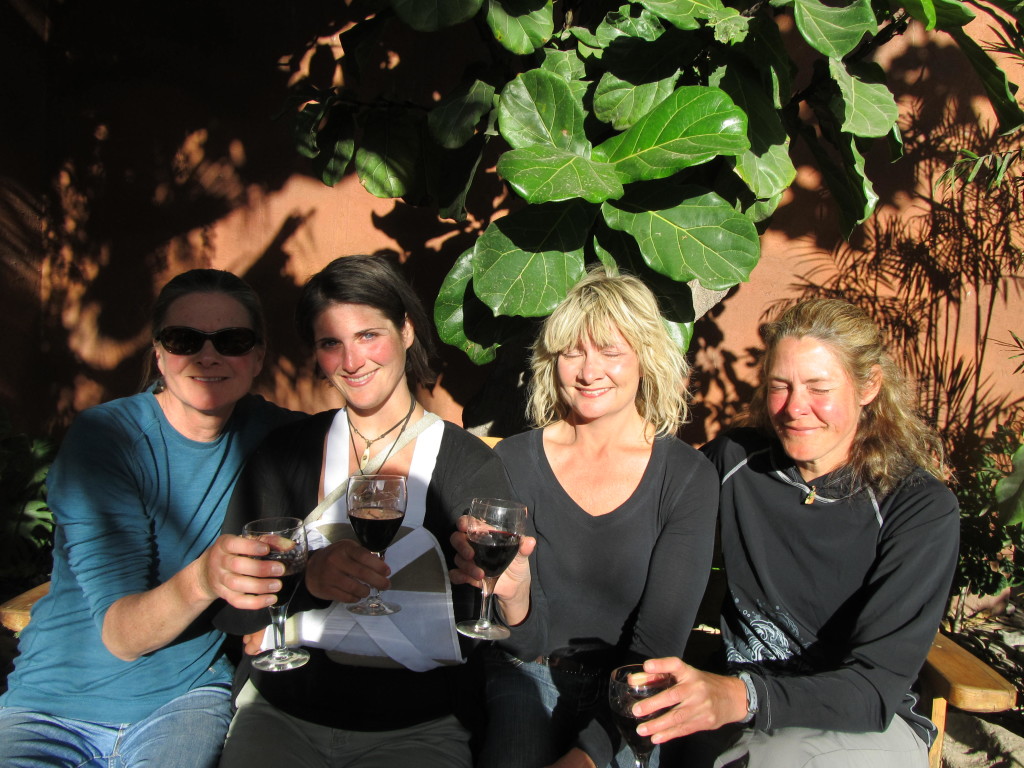 The ladies “survivor’s toast.”
The ladies “survivor’s toast.”
References/Related
- Romano-Lax, Andromeda; Sea Kayaking In Baja; 1995.
- Eckardt, Dave; The Guide to Baja Sea Kayaking; 2008.
- Washburne, Randel; The Coastal Kayaker’s Manual; 1998.
- Wind and Weather and Some Baja Rules; I Wind Surf.com
- Expert Reveals Reasons Behind Recent Shark Attacks, Brianne Randle, 12/5/12.
- Surfer Injured in Shark Attack on Oahu’s North Shore; Brianne Randle, 4/3/13.
- Great White Shark Circles Fishing Boat Off Oahu, Hawaii. Huffington Post, 1/14/12
- Hawaii Shark Encounters
- Shark attacks in Hawaii may be on the increase because of spear fishermen
- Encountering Predators While Kayaking, Athena Holty. Topkayaker.net
- Woman Recovers From Latest Shark Attack off Hawaiian Islands
- Ocean Camp Maine: Incident Reports, Ethics, and the American Canoe Association’s Blind Eye

